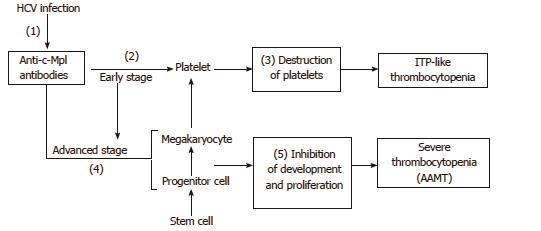Copyright
©The Author(s) 2017.
World J Gastroenterol. Sep 21, 2017; 23(35): 6540-6545
Published online Sep 21, 2017. doi: 10.3748/wjg.v23.i35.6540
Published online Sep 21, 2017. doi: 10.3748/wjg.v23.i35.6540
Figure 3 A schema of the pathogenesis of the current case.
Hepatitis C virus infection may cause the generation of anti-c-Mpl antibodies (1). At first, most of the generated antibodies would be absorbed with the c-Mpl on platelets because platelets are the largest component in the megakaryocyte lineage (2). These antibody-attached platelets are destroyed in the spleen (3), therefore, idiopathic thrombocytopenic purpura (ITP)-like clinical manifestations are observed (Early stage). Following a sufficient reduction of platelets, these antibodies begin to bind to the c-Mpl on the megakaryocytes and its progenitor cells in the bone marrow (4). Attached antibodies block the functions of thrombopoietin, causing inhibition in the development and proliferation of the megakaryocyte lineage (5). Thus, severe reduction of megakaryocytes in the bone marrow occurs, that is, acquired amegakaryocytic thrombocytopenia (AAMT) (Advanced stage).
- Citation: Ichimata S, Kobayashi M, Honda K, Shibata S, Matsumoto A, Kanno H. Acquired amegakaryocytic thrombocytopenia previously diagnosed as idiopathic thrombocytopenic purpura in a patient with hepatitis C virus infection. World J Gastroenterol 2017; 23(35): 6540-6545
- URL: https://www.wjgnet.com/1007-9327/full/v23/i35/6540.htm
- DOI: https://dx.doi.org/10.3748/wjg.v23.i35.6540









